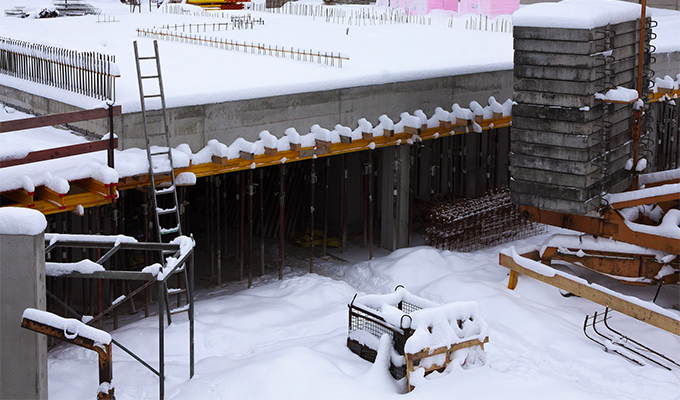You step outside, ready to tackle the day. The cold morning air wraps around you, chasing away the warmth that surrounded you for hours at home. A commercial construction site will be your new home for the next eight hours, and you’re already wondering how you’ll withstand the bitter cold accompanying Old Man Winter.
Research shows that winter weather conditions in 2022 led to 159 deaths and 351 injuries in the U.S. Construction workers are especially susceptible to cold weather problems due to spending hours outdoors, especially when high winds make the temperature even more frigid.
Establishing well-thought-out safety strategies can help you keep yourself and your construction team safe when working outside in the winter. Let’s explore several must-have protocols for commercial construction sites in cold weather.
Get the Gear
An essential part of staying safe at a construction site is investing in the right cold-weather gear. These include hard hats with high-density, thick foam to protect you from impact and freezing weather. Other must-have cold-weather construction gear options include hoodies, jackets, and pants lined with fleece; vests; flannel shirts; layered socks; waterproof boots; and gloves lined with insulating materials (e.g., wool) to keep your hands warm.
Keeping your feet, hands, and head toasty is critical since frostbite usually happens in a worker’s extremities when the temperature dips below 32 degrees Fahrenheit (more on frostbite later). Remember to also pack backup clothing for your worksite so you’ll stay dry. Moisture may accelerate your body’s heat loss, causing your body to more quickly experience cold stress (a dip in your body’s temperature due to cold temps).
Promote Teamwork
Create a “buddy system” for your construction crew to keep everyone safe when the temperature drops. Assigning two people to work together will help ensure no one faces cold-weather hazards alone. If one person becomes weak due to cold stress, the other person can seek emergency help immediately. Make it a habit to monitor your teammate’s physical condition, not just your own, when winter weather strikes.
Maximize the Afternoon
The Occupational Safety and Health Administration recommends scheduling construction work for afternoons during the cold season. Winds are generally less likely to be as strong then, and temperatures may be warmer.
Monitor the Site
Watch out for construction site hazards resulting from severe cold, like icy surfaces. Avoid scheduling work at high elevations, like rooftop repairs or installations, since workers can easily slip and fall. Trips, falls, and slips made up 32% of nonfatal construction site injuries in 2019, which put workers out of commission for 28 days (the median).

Schedule Regular Breaks
Require your construction team members to frequently take breaks in cold weather, especially when the temperature reaches negative 24 degrees Fahrenheit or less. They shouldn’t work any longer than 75 minutes between breaks. Break times are an excellent time for your workers to replace wet clothes with dry ones, rest, and warm up with hot beverages and blankets in dry and toasty areas indoors.
Understand the Signs of Problems
Understanding cold stress symptoms will help you determine if your workers require medication attention due to prolonged cold exposure. These indicators include blisters and numbness. Look out for the following, too:
- Leg cramps
- Swelling
- Pain
- Tingling
- Red skin
Cold stress comes in multiple forms, including hypothermia, trench foot, chilblains, and frostbite. Let’s review these conditions.
Hypothermia
Hypothermia happens when the body’s temperature reaches 94 degrees Fahrenheit or lower. Signs of hypothermia include a slower heart rate, blurry vision, slurred speech, confusion, losing coordination, and shivering uncontrollably. Seek emergency help right away since hypothermia may be fatal if not addressed promptly.
Trench Foot
Trench foot is where your feet tingle, swell, and become numb and red due to being exposed to wetness and cold. This may happen even when the temperature is above freezing outdoors. Injury happens because a wet foot loses heat over 20 times more quickly than a dry foot.
Removing your wet footwear and drying the feet in a warm area as soon as possible may help minimize the adverse effects of trench foot. Workers with trench feet should also elevate their feet and resist the urge to walk, as walking might damage the sensitive tissue.
Chilblains
This condition occurs when the skin’s tiny blood vessels become painfully inflamed due to repeatedly being exposed to cooler temperatures. You could experience it even if the temperature is 60 degrees Fahrenheit. Chilblains symptoms include blistering, itching, and redness. Slowly warming the skin and not scratching it may help relieve the inflammation. Corticosteroid cream might help reduce the swelling and itching.
Frostbite
Frostbite happens when cold temperatures freeze the skin and its underlying tissues. This can lead to permanent blood vessel, nerve, muscle, and skin damage. Symptoms of frostbite include blistering, redness, numbness, skin hardening, and tingling in the ears, nose, toes, and fingers. You may notice white or gray patches develop on reddened skin. Seek medical attention as soon as possible if you experience frostbite.
Keep Your Construction Team Safe This Winter
The top must-have safety protocols for commercial construction sites in cold climates include requiring workers to wear waterproof boots and other cold-weather gear, promoting teamwork, and monitoring the worksite for hazards like ice. Other best practices include working after noon, scheduling frequent breaks, and teaching your team to identify cold stress symptoms. Following these protocols may increase your construction team’s chances of staying healthy and safe in the most frigid weather conditions this winter.
About the Author
Jordan McDowell is a writer and content strategist. He specializes in technically oriented B2B and B2C content for many digital companies.


